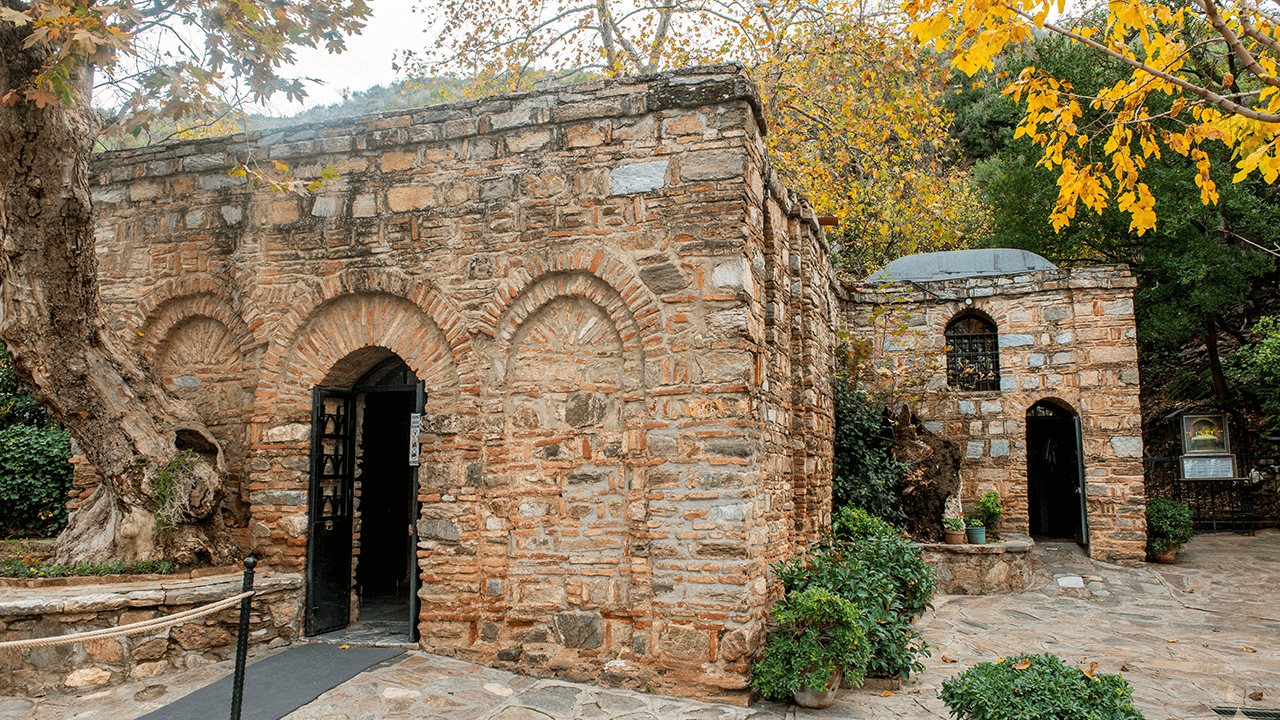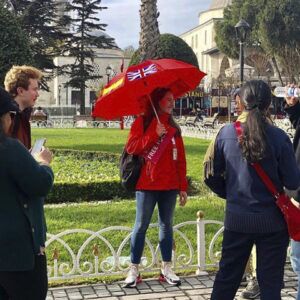The Church of Mary the Double Churches in Ephesus
The Church of Mary in Ephesus is one of the ancient city’s most important monuments, celebrated for both its architecture and its historical and religious significance. Originally built in the 2nd century AD and used as a cultural and educational center known as the “Hall of the Muses,” the building was transformed into a Christian basilica when Christianity became the official religion of the Roman Empire. The Church of Mary is considered the first church dedicated to the Virgin Mary, and its dual-structure architecture has earned it the name of the Double Churches.
History and Origin of the Church of Mary
The original building was constructed during the Roman period, measuring 260 meters in length, and stood out for its basilica structure with columns and an impressive baptistery, one of the best-preserved in Asia Minor. This structure was partially destroyed several times, and the western section was converted into a domed basilica. However, when this part also sustained damage, only the eastern section remained standing and was reused as a church. It is this dual structure feature that gives it the unique name of the “Double Churches.”
The Council of Ephesus and Its Significance
One of the most important events held in the Church of Mary was the Third Ecumenical Council, also known as the Council of Ephesus, which took place in 431 AD under Emperor Theodosius II. This council was crucial for defining Christian doctrine regarding the nature of Jesus Christ and the role of the Virgin Mary.
Theological Controversy and the Role of Nestorius
The Council of Ephesus witnessed a theological clash regarding the nature of Christ and Mary’s role. Nestorius (380-451), Patriarch of Constantinople and leader of the Antiochian school, argued that Jesus Christ had a single human nature, meaning Mary could not be called “Mother of God” but only the mother of Jesus as a man. In contrast, the Alexandrian school maintained a more mystical view, affirming that Mary was theotokos, or “God-bearer.” Ultimately, the council declared that Christ possessed both human and divine natures, allowing Mary to be recognized as the “Mother of God.” This decision resulted in the exile of Nestorius.
Architecture of the Double Churches
The architecture of the Church of Mary reflects the religious and historical transitions that marked Ephesus and the entire Roman Empire. The church was initially designed in a basilica format, with wide columns and a rectangular plan. It included a large space for congregations and a baptistery used for Christian initiation rites. Over time, modifications and reconstructions led to the complex adopting a double-church form, reflecting the architectural practices of the time and the building’s continued use by subsequent Christian communities.
Architectural Features of the Baptistery
The baptistery of the Church of Mary is one of Asia Minor’s most iconic structures, notable for its size and state of preservation. This space was used for baptisms, one of Christianity’s fundamental sacraments, and its design reflects the importance that the baptismal rite held for the Christian community of the time. With a circular layout, the baptistery has a baptismal pool and a dome that lends a sense of spirituality and solemnity to the space.
The Significance of the Church of Mary in Christianity
The Church of Mary holds great importance in Christian history, not only as the first church dedicated to the Virgin Mary but also for its role in the development of Christian doctrine. This temple stands as a tangible testament to the transition of a pagan city into a major center of Christianity. Theological aspects that are central to Christian belief were defined here, and Mary’s role as the “Mother of God” was consolidated.
Visiting the Church of Mary Today
Today, the Church of Mary and the Double Churches are one of the main attractions in the Ephesus archaeological site. This complex has been preserved as a monument to faith and the history of humanity. Visitors can walk through the ruins and appreciate both its architectural value and its spiritual significance. The church is part of the Ephesus tour, allowing tourists to experience firsthand the magnificence of this structure and understand its role in the evolution of Christianity.
Practical Information for Visitors
The Church of Mary is located within the Ephesus complex, accessible from the city of Selçuk. It is recommended to wear comfortable shoes and bring water, as the tour of the ruins can be extensive. Admission to the site includes access to the main ruins of Ephesus, and visitors have the option to hire local guides for a deeper understanding of the church’s history and architecture as well as other structures.
The Cultural and Spiritual Relevance of the Church of Mary
The Church of Mary is a symbol of the influence Ephesus had on Christian history. Its cultural and spiritual value has endured through the centuries, making it a pilgrimage site for many believers and a historical attraction for those interested in ancient civilizations. As the site of the Third Ecumenical Council, the church is also remembered as a place where important aspects of Christian faith were defined, a legacy that continues to draw visitors from around the world.
The Church of Mary and the Double Churches represent not only a chapter in the history of the Roman Empire and Christianity but also one of the many architectural wonders that can be found in Turkey. This site allows us to understand the grandeur of the ancient city of Ephesus and the deep spirituality that characterized this period. From theological debates to defining decisions in Christian doctrine, the Church of Mary is a true treasure for those seeking to understand Christianity’s development in its historical context.



3 thoughts on “The Church of Mary the Double Churches”
★★★★★
Visiting ‘The Church of Mary the Double Churches’ was an extraordinary experience, offering insights and enjoyment like no other. Highly recommended!
★★★★★
I was blown away by everything ‘The Church of Mary the Double Churches’ has to offer. Definitely a place to return to in the future.
★★★★★
My journey to ‘The Church of Mary the Double Churches’ was nothing short of amazing. A must-see for anyone exploring the area!